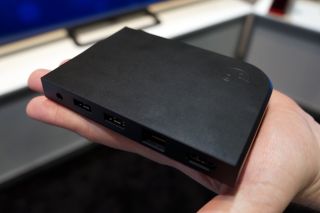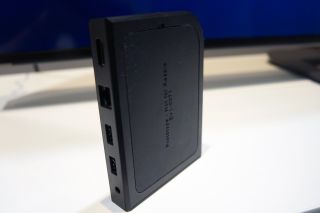Steam Link hands-on: Valve's best shot at the living room costs $50

In November 2015, Valve is finally making its big push into the living room with more than a dozen Steam Machines from hardware partners including Alienware, Falcon Northwest, and Origin. Those Steam Machines range in price from $500 into the thousands. They're fully-fledged PCs, but I wonder if anyone who already owns a PC will want to buy one. Especially because Valve itself will be releasing a device in November that, for $50, will be able to stream any game from your PC to your living room at 1080p, 60 fps. It's called the Steam Link, and it may be the exact device we've been hoping for ever since Valve debuted Steam In-Home Streaming.
Streaming has gotten much, much better since it debuted in January 2014. Valve's programmers have reduced latency, improved compatibility, and added hardware encoding and decoding (using a graphics card to offload some work from the CPU) to maintain a fast and steady video stream. While it takes a beefy host PC to run a game and transcode that game into a 60 fps video stream, the client device, theoretically, doesn't need much in the way of hardware to handle 1080p60 video decoding. $100 Apple TVs and Rokus are easily up to the same task.
Steam Link may well become the ubiquitous device of SteamOS: a cheap, stripped-down Linux box that can play any game from Steam's ballooning 4000+ library, so long as you have a powerful gaming rig on the other end. Valve plans to offer the Link in a $100 bundle with a Steam controller, but it has two USB ports on the back, along with Ethernet (and 802.11ac wi-fi) and HDMI, that will support a USB controller or wireless dongle. If anything gives Valve a foothold in the living room, I think it will be the Steam Link, not the $500+ Steam Machines.
I don't know what hardware Valve has inside the Steam Link, and it's possible it'll change some between now and November. But I did get to see a demo in action, and Steam In-Home Streaming did work with the Link at what looked like a consistent 60 frames per second. Really, nailing the hardware of the Link is the easy part. Ensuring that In-Home Streaming works as efficiently as possible is the make-or-break challenge for the Steam Link.

When Valve demoed the Steam Link for me, I was sitting about three feet away from a 50-inch-or-so 1080p TV—much closer than I'd ever sit in my own living room. At that range, the compression artifacts from the video encode were noticeable. It wasn't a pristine picture, but it was considerably better-looking than the Doko, a similar $100 streaming box. I also didn't notice any lag between my controller movements and actions in-game. And Steam In-Home Streaming's options can be adjusted for quality versus speed; depending on the power of your computer and your home network, it may be possible to maintain a 60 fps stream with a cleaner picture.
The Steam Link hardware itself is heavy. Heavier than it looks given its size, which is like an Apple TV smooshed into a flatter box that still fits in the palm of your hand. According to Valve, that weight comes from the heatsink on the bottom, which serves the dual purpose of keeping the system cool and keeping an errant cable yank from tossing it across the room. Whether it's actually necessary or not, I find the presence of the heatsink reassuring—it makes me think the hardware will most definitely be powerful enough to 1080p60 decoding without dropping frames.
At $50, the Steam Link is half the price I expected for the first great living room PC streaming box. I'm eager to see the final product land this November, open it up, and see exactly what's inside. I'm also a bit worried that Valve is going to cannibalize interest in the machines its hardware partners are building because the Steam Link is so cheap, but we'll have to thoroughly test it with Steam In-Home Streaming to see if it's truly PC gaming's living room killer app.
The biggest gaming news, reviews and hardware deals
Keep up to date with the most important stories and the best deals, as picked by the PC Gamer team.

Wes has been covering games and hardware for more than 10 years, first at tech sites like The Wirecutter and Tested before joining the PC Gamer team in 2014. Wes plays a little bit of everything, but he'll always jump at the chance to cover emulation and Japanese games.
When he's not obsessively optimizing and re-optimizing a tangle of conveyor belts in Satisfactory (it's really becoming a problem), he's probably playing a 20-year-old Final Fantasy or some opaque ASCII roguelike. With a focus on writing and editing features, he seeks out personal stories and in-depth histories from the corners of PC gaming and its niche communities. 50% pizza by volume (deep dish, to be specific).
Most Popular

